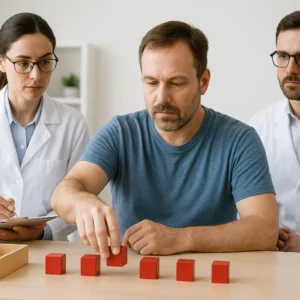Stem Cells come in different types, each with its unique potential. Embryonic stem cells (ESCs) and induced pluripotent stem cells (iPSCs) can transform into any cell type, making them incredibly versatile. Mesenchymal Stem Cells (MSCs), however, specialize in becoming only a few types, like bone, cartilage, or fat cells. That’s why MSCs are often used in therapies: they’re effective yet simpler and safer to work with.
If you’re considering Stem Cell Therapy, our team can guide you in deciding if it’s the right fit, help you choose the best clinic & region, and even assist you in securing some great discounts! Fill in our form here to set up a conversation.
The Specialization Process
MSC Stem cells rely on signals to guide their transformation into specialized cells. These signals, like growth factors, tell the stem cells to become specific cell types.
Becoming Bone (Osteoblasts): Research shows that MSCs exposed to bone-growth signals produce collagen and minerals, forming bone tissue. It’s like following instructions to build a house—except it’s bone instead of bricks.
Becoming Cartilage (Chondrocytes): In another study, researchers used growth factors to guide MSCs into forming cartilage. The cells picked up these signals and created the flexible tissue that cushions joints.
Becoming Fat (Adipocytes): Scientists placed MSCs in fat-promoting environments, where the cells stored fat droplets and activated fat-specific genes. This process helps with energy storage.
Broader Role in Healing
MSCs do more than just transform. They send out healing signals known as paracrine factors—growth factors and cytokines that reduce inflammation and activate the body’s repair mechanisms. Even if MSCs don’t become new cells, these signals create an ideal environment for healing.
Do Stem Cells Always Specialize?
Cells don’t always specialize as planned. If the signals aren’t clear, the cells might not differentiate properly. Think of it as trying to follow unclear instructions—things can get confusing.
How Scientists Improve Cell Specialization
Researchers are perfecting methods to guide MSCs. They use growth factors, mechanical stimulation (like giving cells a workout), and gene editing. These techniques help ensure that stem cells specialize correctly for consistent treatment outcomes.
Conclusion
So how do Stem Cells become specialized? To conclude, MSCs can become bone, cartilage, or fat cells, but their real power lies in their healing signals. This dual role makes them essential for medical treatments. While challenges remain in ensuring they differentiate as planned, ongoing research is making Stem Cell therapies more reliable and effective.
To read about the different types of Stem Cells, we put together an article covering each type of Stem Cell here.
We provide you with unbiased information helping you learn about Stem Cell Therapy & see if it’s right for you. Our platform can also connect you with the best clinics in the right areas & get you some cool discounts! Fill out our form here to learn more. ( Our Find a clinic page is coming soon!)
It really depends on the person and the condition. For some, the effects can stick around for months or even years; for others, the benefits may need a boost with follow-up treatments. Factors like the type of stem cell, where it’s used, and how your body responds all play a part. We also don’t have all the long term data to truly know the answer.
You can find treatments for diabetes in places like the U.S., Mexico, and some spots in Asia & Europe. Regulations and treatment options vary.. Countries like Mexico and some in Asia offer way more cells in their treatments, while the U.S. and Europe have stricter rules. You might want to look into the science to see if you really want to do it first, check out the recent studies here first.
After stem cell treatment, avoid heavy lifting, intense exercise, and high-impact activities for at least a couple of weeks—let those cells settle in! Try not to smoke or drink excessively, as it can slow down healing. And, resist the urge to take anti-inflammatory medications (like ibuprofen), since they can interfere with the cells’ effects.
Fill in your details below
For a discounted offer for Stem Cell Therapy!






